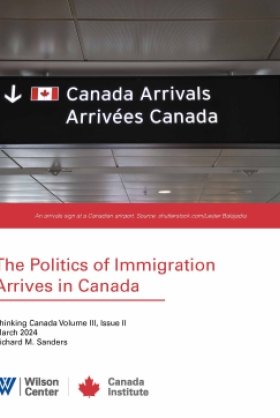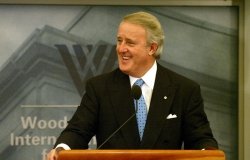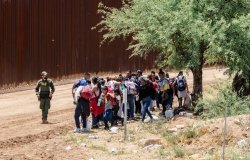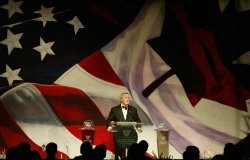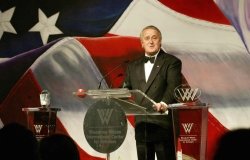Rebuilding and Renewing America: Toward a 21st Century Infrastructure Investment Plan
Overview
Hon. Earl Blumenauer, U.S. House of Representatives (D-OR); Hon. Jim Oberstar, Chairman, House Transportation and Infrastructure Committee, U.S. House of Representatives (D-MN); Hon. Edward Rendell, Governor, State of Pennsylvania; Hon. Rosa DeLauro, U.S. House of Representatives (D-CT); Hon. Tom Petri, U.S. House of Representatives (R-WI); Hon. Christopher Shays, U.S. House of Representatives (R-CT); Judith Rodin, President, The Rockefeller Foundation; Robert Yaro, President, Regional Plan Association; Terence M. O'Sullivan, President, Laborers' International Union of North America; Thomas J. Donohue, President and CEO, U.S. Chamber of Commerce; Jonathan F. P. Rose, President, Jonathan Rose Companies. Co-sponsored by the Rockefeller Foundation, the Lincoln Institute of Land Policy, Regional Plan Association, and the Surdna Foundation
As consumers contend with record gas prices, a crumbling energy and transportation infrastructure and the specter of climate change, participants from the labor, political and financial sectors asserted during a day-long conference sponsored by the Division of U.S. Studies that it is time for the nation to engage in long-range planning for the infrastructure development needed to meet these challenges. Just as the Gallatin plan of 1808 and the Roosevelt plan of 1908 guided the development of the United States' infrastructure to meet the social and economic challenges of the 19th and 20th centuries, so, the participants argued, this nation needs a plan for the 21st century.
Any such plan, the panelists agreed, must include cooperation at the state, local and federal levels; public/private partnerships; public education; and presidential leadership. By 2050, 70 percent of the population of the United States will be concentrated in large urban mega-regions. This presents an opportunity for the federal government to help local governments improve the inter-city flow of goods and services for the sake of both the economy and the environment. Development of inter-city transit such as inter-city high-speed rail, for example, would improve commerce, save energy, help the environment, and create jobs. It would save American consumers from wasting energy during traffic congestion which, according to Judith Rodin, cost our economy $78 billion in 2005, adding 4.2 billion hours to Americans' commutes while wasting 2.9 billion gallons of gasoline. The transportation crisis has a class component. Working families in large metropolitan areas spend nearly a third of their incomes on transportation. Two of every three regular users of public transportation earn less than $50,000 a year. The federal government, however, directs only one of every five gas-tax dollars to automobile alternatives.
Public funds cannot handle the necessary infrastructure improvements alone, Rep. DeLauro cautioned, so the government must encourage investment from private funding sources. Dr. Rodin noted that the philanthropic sector has a role to play as well because it has the money to fund cutting-edge research. Regardless of the make-up of the congressional and executive branches next year, creating policy incentives for public and private investment in the nation's infrastructure will be imperative. The American public, Rep. Shays urged, must be made aware that "there is more than one inconvenient truth."
- - - - -
In addition to the plenary sessions, the conference included three roundtables.
Energy Roundtable:
Bob Baugh, Executive Director, AFL-CIO Industrial Union Council; Daniel Braun, Director, Global Environmental Finance, Stark Investments; Mark S. Dodson, CEO, NW Natural; Michael Eckhart, President, American Council on Renewable Energy; Joseph P. Oates, Vice President of Energy Management, Consolidated Edison Inc.; Richard T. Thigpen, Vice President, State Government Affairs, Public Service Enterprise Group, moderator.
The panelists discussed how the United States might meet current energy needs while furthering the production of renewable energy resources. The federal government should follow the example of Brazil and the Netherlands by devoting funds to renewable energy production, Bob Baugh suggested. Without such investment, Joe Oates warned, the United States might have to face the prospect of buying parts for renewable energy products from other countries. The participants of the energy roundtable agreed it is incumbent upon public and private entities to work together to meet this challenge. Private funds could play a significant role in renewable energy production, Michael Eckhart asserted, if policy incentives, such as tax credits for investing in renewable energy sources, were consistent. The use of green tags or renewable energy certificates – a system of steering money toward renewable resources through utility companies – is a good example of creating incentives for the private sector. Mark Dodson noted that as the nation increases renewable energy production, the existing infrastructure for the still-necessary traditional energy sources upon which production of renewable resources depends in part will need to be fortified and expanded.
Transportation Roundtable:
Rob Puentes, Fellow, Brookings Metropolitan Policy Program; Paul Weyrich, Chairman and CEO, Free Congress Foundation, and Commissioner, National Surface Transportation Policy and Revenue Study Commission; MarySue Barrett, President, Metropolitan Planning Council of Chicago; Mariia Zimmerman, Vice President for Policy, Reconnecting America; T. Peter Ruane, President and CEO, American Road and Transportation Builders Association; Mort Downey, Chairman, PB Consult Inc., moderator
What, the transportation workshop asked, is a broad and understandable vision of transportation infrastructure in the United States? The participants agreed that it is necessary to develop both a vision and a way of getting public support behind it. Rob Puentes suggested that a federal vision is needed but the federal government should give more leeway to the states and localities while focusing on performance-based grants and demanding more accountability from grantees. Paul Weyrich, arguing for creation of 16 high speed corridors, added that too much time now lapses between a locality's identification of its needs and its receipt of the necessary federal funding. T. Peter Ruane asserted both that the financial and business communities are now involved in the infrastructure issue and that current institutions are not performing well. Congress has too few hearings about infrastructure; the Department of Transportation is close-minded and focused on guidelines that cannot be implemented; the states do not have the talent or resources to do the job. Mariia Zimmerman, saying that a map of what the country would look like if it had high-speed transportation might be part of the answer to raising public awareness and support, also urged a more aggressive attempt to secure climate control funds for the country's transportation infrastructure needs.
Water roundtable:
Steve Allbee, Director, Gap Analysis, US EPA; Sally Collins, Associate Chief, USDA Forest Service; Betsy Otto, Senior Director, Healthy Waters Campaign, American Rivers; Kevin Shafer, Executive Director, Milwaukee Metropolitan Sewerage District; Albert Appleton, former Commissioner, New York City Department of Environmental Protection, moderator
Water is a finite resource, and the future is about management and aggressive international collaboration on sustainability. Solutions to a sustainable clean water supply demand thinking creatively and collaboratively about how to manage water resources much more effectively. Among the recommendations offered by Betsy Otto were minimizing new infrastructure in favor of natural systems - 20 percent of potable water is lost by leaky pipes, and sprawl contributes many miles of pipe, paving and runoff; decentralizing the layers of local, state, and federal regulations; and planning for the impact of climate change in the face of net evaporation from global warming. Civil engineers studying American infrastructure give the lowest grade to dams, sewers and water systems. More than 72,000 miles of municipal water and sewer pipes are more than 80 years old. According to Steve Allbee, the current cost of water is unconscionably low, while capital and repairs costs are going to increase exponentially. Local consumers must be educated about costs so that they know what they are getting for their money. Kevin Shafer advocated unified permitting in watershed planning, using nature's boundaries, not just political ones and, importantly, dedicated funding, not the seesaw funding from varying federal and local sources. Observing that one person's wastewater is someone else's drinking water, he admitted uncertainty about the way to deal with pharmaceuticals in the water but asserted our dependence on technology to help solve the problem. Sally Collins discussed the importance of building an economic engine behind watershed use and tracking markets so we know where to invest, and suggested that the Forest Service can assist in creating water markets, biodiversity markets, and ecosystem services with green solutions.
- - - -
Rep. Blumenauer and a bipartisan group of House co-sponsors have introduced legislation calling for a U.S. Commission on Rebuilding America for the 21st Century. The Commission, to be appointed by Congress, the President, and state and local governments, would identify challenges and needs, hold public hearings on infrastructure in at least 50 congressional districts, and articulate a national vision for infrastructure investments. That kind of national vision, all the participants agreed, is crucial if the nation is to remain economically vibrant.
Division of United States Studies (202) 691-4127
Thank you for your interest in this event. Please send any feedback or questions to our Events staff.


